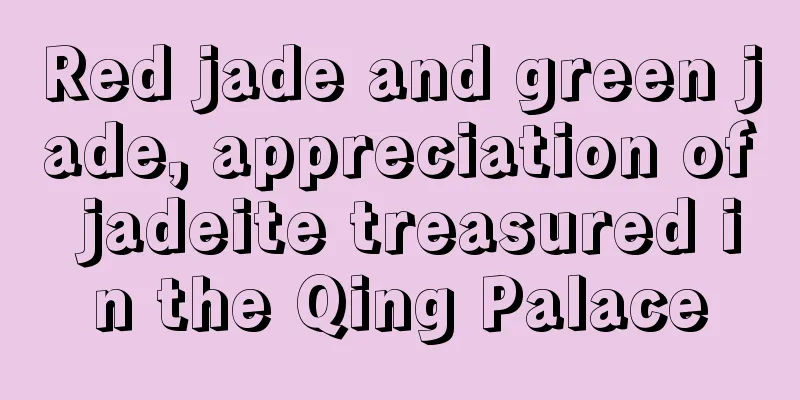Red jade and green jade, appreciation of jadeite treasured in the Qing Palace

|
Openwork lotus and duck jadeite inlay Jadeite originates from the mountainous area of Myanmar in South Asia and was not a traditional raw material for making tools in ancient China. In the Ming Dynasty, jadeite began to be used in small quantities by princes and nobles. By the middle of the Qing Dynasty, it was widely used in the palace. In the late Qing Dynasty, because Empress Dowager Cixi had a special preference for jadeite, her jewelry was often made of emerald green jadeite. Jadeite was also used for treasures and furnishings in the palace, which inspired aristocratic women to generally favor jadeite and led social trends towards an extreme love for jadeite. From then on, jadeite became an integral part of traditional jadeware. The reason why jadeite quickly became popular among the Chinese people in the Ming and Qing dynasties was, first of all, because of its rarity and stunning beauty. Those colors, like the emerald green of a deep pool, the verdant green of a bamboo grove, the red of the sunset, and the white of the clouds in the sky, all became the objects of dreams and fantasies of the world. The second reason is that jade itself is extraordinarily hard. Jade is one of the harder varieties of all jades. Whether it is cutting or carving, it poses a huge challenge. Therefore, to create a piece of work, in addition to basic jade carving skills, it also requires greater perseverance and stunts, otherwise it will be impossible to complete its reshaping. The carved jade products have a timeless luster due to their extraordinary hardness. Jadeite was called Cuishengshi in the Ming Dynasty, and was called Yunyu and Dianyu by people in the Qing Dynasty. In recent years, in addition to green, red and white jadeite, violet, dark brown, black or red, green and purple jadeite have also received attention. However, in traditional concepts, bright green, watery, glassy and old jadeite is still the king of all colors of jadeite. Jadeite jewelry sold at sky-high prices in the international auction market are all glassy, watery, old-type high-quality jadeite or bright jadeite, reflecting people's basic aesthetic awareness of appreciating jadeite. Judging from traditional jade products, since the raw materials of jade are usually less in quantity, the carved products are generally smaller than other jade products. Judging from the jade products handed down from the Qing Palace, the large objects were mostly finely carved bottles, pots, basins, etc., but in relatively small quantities. The jade products in the palace were mainly small and medium-sized objects, most of which were carved into jewelry and playthings, such as bracelets, hairpins, hairpins, rings, court beads, bracelets, pendants, hat crowns, feather tubes, thumb rings, etc. Most of the jade products collected by the Shenyang Palace Museum are relics of the Qing Palace. Some of them were used by the emperors and concubines of the Qing Dynasty. In addition to being highly ornamental, they also have important historical and artistic value, and therefore have become a special part of the jade collection in the museum. The jadeite artifacts from the Qing Dynasty currently in the Shenyang Palace Museum include jadeite ornaments, pendants, court beads, and stationery items made in the mid-Qing Dynasty, as well as jewelry, pendants, inlays, and tobacco bottles from the late Qing Dynasty. The materials used include large pieces of raw materials that are hard to come by, old pit glass with plenty of water, red jadeite as red as the morning glow, green jadeite as green as a deep pool, and two-color materials that are a combination of jade and emerald. They are meticulously crafted and are beautiful beyond words. The jadeite collections in the Shenyang Palace Museum come from a variety of sources: part of them are old collections from the Qing Palace, part of them are collected from society in the 1960s and 1970s, and a large part of them are from the personal collections of the last emperor and empress of the Qing Dynasty, Puyi and Wanrong. Jade plaque with carved twin lions Jade plaque with double coin pattern Skillfully carved autumn leaves and crickets, jadeite offering A pair of eggplant-shaped jadeite snuff bottles Jadeite pendant with carved dragon, beast, cloud and bat Jade Ring Jade belt buckle with Kui pattern Jade belt hook with dragon pattern A Jadeite Carved Lentil Pendant fruit fcpf99 feicuibbs1 fcgc60 |
>>: How to choose and buy jadeite?
Recommend
Popular Science Post - Several Methods for Identifying Natural Jade
Friends often hold up a piece of jade and ask me ...
Is jadeite raw stone expensive? Will it appreciate in value?
Is jadeite raw stone expensive? Of course it’s ex...
Jade of different colors has very different meanings! Did you make the right choice?
There is a saying circulating in the jade industr...
Why are “Jieyang craftsmen” so powerful in the jade industry?
Anyone who is engaged in jade-related work must h...
From an inconspicuous piece of jadeite, the jade carving master meticulously crafted it into such a perfect work!
This is a piece of ice-type yellow jadeite with y...
Do you know which jade bracelet style is suitable for you?
Do you know which jade bracelet style is suitable...
Experts explain how to distinguish between A-grade jadeite and dyed jadeite
In the jade industry, jade is definitely a major ...
Why invest in jade? Is jade worth investing in?
At present, after more and more people have solve...
Do you appreciate the magnificent jade carvings?
Using different carving techniques will leave dif...
Is there any possibility that the price of jadeite will drop?
The current market prices for jade have remained ...
The Shadow of Lovers——Myanmar’s National Treasure Jadeite
Today I bring you a piece of top-quality Moshisha...
Do you know the meaning of wearing a jade bracelet?
In the kingdom of jewelry, many women have a spec...
Jade scraps plus excellent creativity, the effect is beyond imagination
When it comes to jadeite with ancient charm and a...
Jade carving customization|It is a pursuit of individuality and a good way to save time
Some people think fish are romantic Because of th...
Because of the right choice of subject matter, this jadeite stone instantly increased 10 times after being carved
As we all know, for a piece of jadeite raw stone ...









